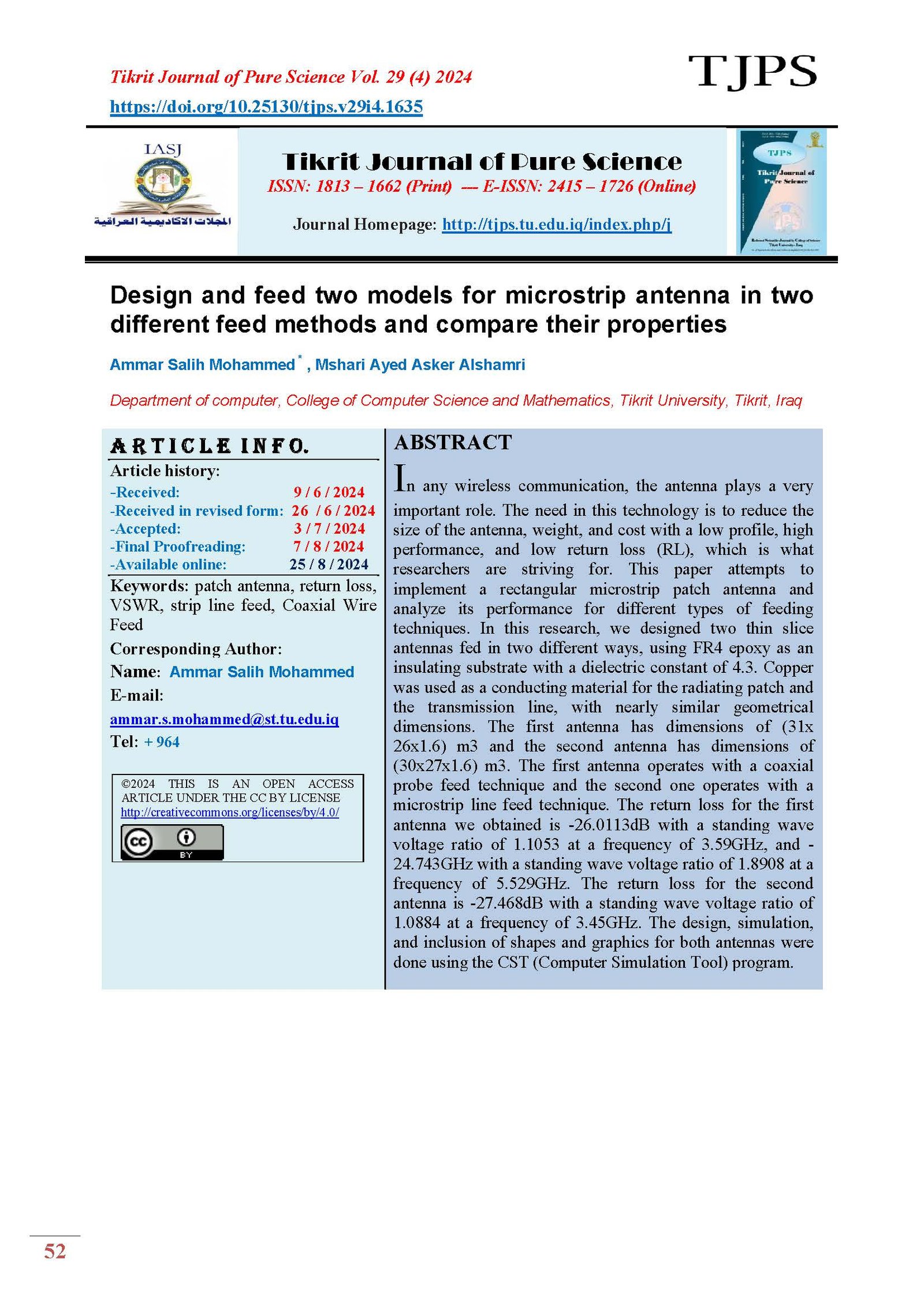Design and feed two models for microstrip antenna in two different feed methods and compare their properties
Main Article Content
Abstract
In any wireless communication, the antenna plays a very important role. The need in this technology is to reduce the size of the antenna, weight, and cost with a low profile, high performance, and low return loss (RL), which is what researchers are striving for. This paper attempts to implement a rectangular microstrip patch antenna and analyze its performance for different types of feeding techniques. In this research, we designed two thin slice antennas fed in two different ways, using FR4 epoxy as an insulating substrate with a dielectric constant of 4.3. Copper was used as a conducting material for the radiating patch and the transmission line, with nearly similar geometrical dimensions. The first antenna has dimensions of (31x 26x1.6) m3 and the second antenna has dimensions of (30x27x1.6) m3. The first antenna operates with a coaxial probe feed technique and the second one operates with a microstrip line feed technique. The return loss for the first antenna we obtained is -26.0113dB with a standing wave voltage ratio of 1.1053 at a frequency of 3.59GHz, and -24.743GHz with a standing wave voltage ratio of 1.8908 at a frequency of 5.529GHz. The return loss for the second antenna is -27.468dB with a standing wave voltage ratio of 1.0884 at a frequency of 3.45GHz. The design, simulation, and inclusion of shapes and graphics for both antennas were done using the CST (Computer Simulation Tool) program
Article Details

This work is licensed under a Creative Commons Attribution 4.0 International License.
Tikrit Journal of Pure Science is licensed under the Creative Commons Attribution 4.0 International License, which allows users to copy, create extracts, abstracts, and new works from the article, alter and revise the article, and make commercial use of the article (including reuse and/or resale of the article by commercial entities), provided the user gives appropriate credit (with a link to the formal publication through the relevant DOI), provides a link to the license, indicates if changes were made, and the licensor is not represented as endorsing the use made of the work. The authors hold the copyright for their published work on the Tikrit J. Pure Sci. website, while Tikrit J. Pure Sci. is responsible for appreciate citation of their work, which is released under CC-BY-4.0, enabling the unrestricted use, distribution, and reproduction of an article in any medium, provided that the original work is properly cited.
References
[6] Tao, L., Xu, J., Li, H., Hao, Y., Huang, S., Lei, M., and Bi, K. (2018). Bandwidth enhancement of microstrip patch antenna using complementary rhombus resonator. Wireless Communications and Mobile Computing, 2018(1), https://doi.org/10.1155/2018/6352181
[3] Saeidi, T., Ismail, I., Wen, W. P., Alhawari, A. R., and Mohammadi, A. (2019). Ultra‐wideband antennas for wireless communication applications. International Journal of Antennas and Propagation, 2019(1), https://doi.org/10.1155/2019/7918765 .
[4] Ojaroudi Parchin, N., Jahanbakhsh Basherlou, H., Al-Yasir, Y. I., Abd-Alhameed, R. A., Abdulkhaleq, A. M., and Noras, J. M. (2019). Recent developments of reconfigurable antennas for current and future wireless communication systems. Electronics, 8(2), 128, http://dx.doi.org/10.3390/electronics8020128
[5] Reis, P., and Virani, H. G. (2020, July). Design of a compact microstrip patch antenna of FR-4 substrate for wireless applications. In 2020 international conference on electronics and sustainable communication systems (ICESC) (pp. 713-716). IEEE, https://doi.org/10.1109/ICESC48915.2020.9156024 .
[6] Abdulhussein, A. M., Khidhir, A. H., and Naser, A. A. (2021, December). 2.4 GHz microstrip patch antenna for S-band wireless communications. In Journal of Physics: Conference Series (Vol. 2114, No. 1, p. 012029). IOP Publishing, https://doi.org/10.1088/1742-6596/2114/1/012029
[7] Shamim, S. M., Uddin, M. S., Hasan, M. R., and Samad, M. (2021). Design and implementation of miniaturized wideband microstrip patch antenna for high-speed terahertz applications. Journal of Computational Electronics, 20, 604-610, https://doi.org/10.1007/s10825-020-01587-2
[8] Narayan, M., Verma, K. K., and Baskey, H. B. (2020).comparison between coaxial probe feed rectangular microstrip patch antenna and proximity coupled feed rectangular microstrip patch antenna for wireless application. Perspective, 7(06).
[8] Bansal, A., and Gupta, R. (2020). A review on microstrip patch antenna and feeding techniques. International Journal of Information Technology, 12(1), 149-15
[9] Das, H., and Sharma, M., Xu, Q. (2022). Microstrip Antenna: An Overview and It Performance Parameter. In: Malik, P.K., Lu, J., Madhav, B.T.P., Kalkhambkar, G., Amit, S. (eds) Smart Antennas. EAI/Springer Innovations in Communication and Computing. Springer, Cham. https://doi.org/10.1007/978-3-030-76636-8_1.
[10] Lee, G. H., Mohyuddin, W., Kumar, S., Choi, H. C., and Kim, K. W. (2021). Compact Wideband Coplanar Stripline-to-Microstrip Line Transition Using a Bended Structure on a Two-Layered Substrate. Electronics, 10(11), 1272.
[11] Kshitija, T., Ramakrishna, S., Shirol, S. B., and Kumar, P. (2019, February). Micro-strip patch antenna using various types of feeding techniques: An implementation. In 2019 International Conference on Intelligent Sustainable Systems (ICISS) (pp. 318-322).
IEEE, https://doi.org/10.1109/ISS1.2019.8908066 .
[12] Faisal, M., Gafur, A., Rashid, S. Z., Shawon, M. O., Hasan, K. I., and Billah, M. B. (2019, May). Return loss and gain improvement for 5g wireless communication based on single band microstrip square patch antenna. In 2019 1st International Conference on Advances in Science, Engineering and Robotics Technology (ICASERT) (pp. 1-5). IEEE, https://doi.org/10.1109/ICASERT.2019.8934474 .
[13] Rana, M. S., and Rahman, M. M. (2022, January). Study of microstrip patch antenna for wirelesscommunication system. In 2022 International Conference for Advancement in Technology (ICONAT) (pp. 1-4). IEEE.
